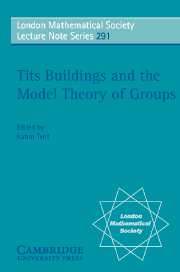Book contents
- Frontmatter
- Contents
- Preface
- List of speakers and talks
- Basics on buildings
- An introduction to generalized polygons
- Buildings and classical groups
- Twin buildings
- Twin trees and twin buildings
- Simple groups of finite Morley rank of even type
- BN-pairs and groups of finite Morley rank
- CM-trivial stable groups
- Amalgames de Hrushovski: Une tentative de classification
- Rank and homogeneous structures
- Constructions of semilinear towers of Steiner systems
- Introduction to the Lascar Group
Rank and homogeneous structures
Published online by Cambridge University Press: 12 January 2010
- Frontmatter
- Contents
- Preface
- List of speakers and talks
- Basics on buildings
- An introduction to generalized polygons
- Buildings and classical groups
- Twin buildings
- Twin trees and twin buildings
- Simple groups of finite Morley rank of even type
- BN-pairs and groups of finite Morley rank
- CM-trivial stable groups
- Amalgames de Hrushovski: Une tentative de classification
- Rank and homogeneous structures
- Constructions of semilinear towers of Steiner systems
- Introduction to the Lascar Group
Summary
The notion of constructing a homogenous structure was introduced in the 1950's by Fraïssé. It was extended by Jonsson from countable to uncountable relational structures. In 1969, Grzegorczyk asked how many theories are categorical in ℵ0. The amalgamation construction was quickly used to show there are continuum many such theories. These constructions clearly gave rise to unstable structures. As stability theory developed, the problem of classifying stable ℵ0-categorical structures arose. Lachlan and Shelah showed that every superstable ℵ0-categorical theory was ω-stable. Work of Cherlin, Harrington, Lachlan, Hrushovski and Zilber showed there were only countably many ω-categorical, ω-stable structures (and much more). But, Lachlan's conjecture that there was no strictly stable ℵ0-categorical structure remained open until the late 80's.
Mainly in infinitary contexts Shelah (e.g.) had studied variants of the construction which strengthen amalgamation to ‘free amalgamation’. The freeness of the amalgamation corresponds to a stability condition. But in Hrushovski provided a concrete way of constructing such amalgams. With this method he refuted both Lachlan's conjecture and Zilber's conjecture that every strongly minimal set was ‘bi-interpretable’ with a discrete set, a vector space, or a field.
As we outline below these are two of a large family of variants of the amalgamation construction, which are determined by what we call here a ‘rank’ function on a class of models.
- Type
- Chapter
- Information
- Tits Buildings and the Model Theory of Groups , pp. 215 - 234Publisher: Cambridge University PressPrint publication year: 2002
- 1
- Cited by



